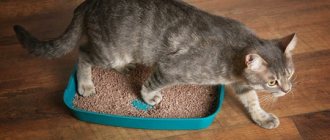A variety of circumstances can cause a cat to avoid using a pee or poop litter box.
Sometimes it is a behavioral problem, but sometimes a health condition can lead to this turn of events.
If left untreated, health problems such as urinary tract infections can lead to life-threatening conditions.
The first sign that your cat may start pooping outside of the litter box is when a cat that used to always bury its poop stops doing so. This means that new “surprises” may follow.
Stress and behavioral problems
A sudden change in your pet's litter box behavior can be attributed to several reasons, many of which boil down to feline stress.
Litter box odor: It is very common for cats to avoid a litter box if it does not meet their standards of cleanliness and odor. If it's not clean, even cats who have been toilet trained for years may abandon it in favor of another location (usually one that will get your attention).
Wrong location of the drawer. If it's near a door or in an area of the house that gets a lot of traffic or where the cat can't easily reach, consider moving it. But this is not recommended if the cat has dementia, as it can create even more confusion.
If another cat or animal appears in the house, or a new child, or someone moves in or moves out, the cat may begin to mark its territory. This will be temporary until the cat gets used to the new situation.
But keep in mind that any change in your cat's daily routine or environment can cause her stress. And he, in turn, leads to unusual behavior.
It may take several weeks or months for a newly adopted cat to fully adjust and feel comfortable enough. The cat may feel a little unsure at first, which may cause problems with the litter box.
Reason: the cat is marking his territory
The cat recently started peeing in the wrong places, but mostly goes to the litter box? Perhaps he is marking his territory. This will require castration. But occasionally it happens that a neutered cat continues to mark. This happens due to habit or stress when the cat feels insecure in its own territory. This problem can be solved by adjusting the habitat.
The problem of marks can also occur in cats, especially if there are several of them in the house. And in general, if there is more than one cat in a family, this is a provoking factor for marks. In this case, you need to try to normalize the relationship between the pets. And they need not one toilet for two, but... three. There should be one more tray than there are cats. The trays should be placed in different places: in those places where you most often find “gifts”.
Cleaning
First of all, remove clumps from the litter box daily and clean it frequently and thoroughly. This means discarding the old litter, washing the empty box with mild dishwashing soap and warm water, rinsing with clean water, air drying, and refilling with fresh, unscented litter (sometimes scented material can be unappealing to picky cats).
Whenever you interact with the litter box, always use rubber gloves and a face mask to protect yourself from microscopic insects and dust.
Warning
If you are pregnant, delegate all litter box care to another family member to reduce the risk of contracting toxoplasmosis.
What to do if a cat, cat, kitten craps at home
It’s worth noting right away that if a cat shits in secluded corners of the apartment, spoils property and personal belongings, after the root cause of such behavior has been established, weaning the pet from harmful behavior will take some time. If a cat, cat, kitten shits, be patient. Do not use physical force or painful force on animals. This approach can only aggravate the situation and your beloved pet will do evil.
Observe the animal carefully. Study your pet's behavior patterns. Look where the cat prefers to do his “tricks”. Close access to hard-to-reach places that your pet has chosen for the toilet. If your cat poops on the carpet, replace the carpeting.
If the cat shits, there is such a possibility, limit the pet’s movement around the apartment until the cat begins to regularly go to the litter box. Close the fluffy one in one room, put a tray with sand and filler there. Provide your pet with fresh drinking water and food. After three to four days of isolation, the cat should develop the correct conditioned reflex.
Place three or four trays of various shapes and sizes in the places that the cat has chosen for its toilet. If your cat constantly poops, try using different litters. In this case, leave one of the trays without sand, placing a grate on top. Most cats prefer fine-grained powders that they can dig into. Keep track of which litter box your cat chooses and with which filling. As soon as the pet begins to constantly go to the same litter box, remove the rest, gradually moving the cat litter box 40-50 cm daily to the desired location.
If an adult cat, kitten, cat shits, but you got a pet recently, be sure to ask the previous owners or breeders what kind of litter was used. Purchase in advance everything you need to care for and maintain your cute furry.
If the animal goes to the tray as intended, be sure to reward it with a gentle tone and a favorite treat . This will help your cat form positive associations about using the litter box. Do not distract or frighten the cat when the pet relieves itself.
You should always keep the trays clean. Cats are clean animals, so the cat shits in the wrong places if the owner does not clean the cat litter in a timely manner. You need to clean the tray at least twice a day. Otherwise, the cat will pee anywhere.
If the cat is already pooping and has started peeing in the wrong place, wait until the pet does its business. After an offense, poke the cat into the puddle, scold the pet in a stern tone, take it to the tray and praise it. Blot the excrement with a napkin and place the soaked, scented paper in the cat's litter box.
© shutterstock
It is very important to get rid of, eliminate the smell of cat marks where the cat, the cat shits, leaves its “surprises”. For these purposes, use household chemicals, as well as special products (Antigadin) that will help eliminate the smell of kitten urine.
What should you do if it’s not a disease?
If your veterinarian has ruled out medical causes for the problem, your next step is to look for real psychological reasons why your cat isn't using the litter box.
For example:
— A cat whose owner’s work schedule has changed may stop using the litter box. Adjusting to a new routine may take up to two weeks or more.
-If you're away for a long period of time, you'll smell different, which can also disrupt your cat's toilet habits.
— A stressed cat may temporarily stop using its box after a big event. This could be moving to a new home, the arrival or departure of family members, the appearance or disappearance of other animals.
— A bored cat can also have problems with the litter box. Therefore, give your cat plenty of toys and daily entertainment to prevent boredom.
— Another problem may be related to the tray itself, which does not correspond to the pet’s wishes.
The litter box smells bad
The tray may not be clean enough. Smell is of great importance for cats, because they are very clean. The litter scoop should also be clean. Otherwise, its unpleasant smell, which a person cannot feel, can scare away the pet.
If the tray is clean, it may smell like detergent or overly scented soap with various additives. The cat does not catch his scent, which he has already marked the toilet with many times. This scares him and discourages him from using the litter box. Therefore, after washing, the cat’s “signature” smell should remain in it, prompting you to go there again and again.
Learned behavior
But “marks” can also play a cruel joke on the owners - after all, they remain where the cat has already done its business. That is, on the carpet or in the same slippers or shoes. And the shoes may well become a kind of “double” of the tray, and for obvious reasons. That is why it is so important to quickly eliminate the consequences of an accident. And not only in terms of cleanliness and hygiene, but in terms of eliminating the “beacon” smell. At one time, in response to a reader’s letter, we prepared a separate publication. Please take the time and read it, there is a lot of useful practical advice there.
Introduce your kitten to his litter box
Here's how you can help train your kitten to pee and poop in the litter box once you've got your supplies and litter boxes set up.
Step 1: Show your kitten where each litter box is and let him smell them.
Step 2: Gently place the kitten in the litter box. The kitten will instinctively start digging for litter or even try to eat it. Perhaps he will immediately guess what this box is for, but it may also be that you will need time.
Step 3: If your kitten did not use the litter box when first introduced, try putting the kitten in one of the litter boxes every time he eats, drinks, or wakes up from a nap until the kitten uses the litter box for its intended purpose.
Reinforce good litter box habits.
When your kitten uses the litter box correctly, reward him with his favorite treat to create a positive association with the activity.
For this to work, the treat must be given immediately after he leaves the tray so that he associates the action with the reward.
If your kitten makes a mistake, DO NOT punish him or yell at him. Calmly clean up the mess with an enzyme cleaner and don't react in any other way.
Keep litter trays clean
Try to clean your kitten's litter box after using it. You don't want your kitten to develop an aversion to the litter box during training. After cleaning the litter box, add some clean litter to maintain a litter depth of 5 to 7 cm to give your kitten plenty of room to dig.
Once your kitten is old enough to use the litter box regularly, you can clean it daily rather than every time your kitten poops or urinates.
Periodically empty all trash from each tray, empty the drawers, and refill with clean litter. Most litters have label recommendations for how often they should be changed.
Combination litters only need to be completely changed every week or couple of weeks, depending on how many cats use your litter boxes.
How to train a kitten to use a litter box
The kitten experiences stress when it finds itself in a new place, so it is better to begin its acquaintance with the house gradually.
Step 1.
Limit his location to just one room, such as your bedroom or kitchen, for at least a couple of days, and try not to let him leave this area. Install the tray there as well. This will make it easier for the kitten to remember the location of objects and the path to the toilet.
Step 2.
Place the baby in the tray. Let him get used to the smell and look around. Do not forcefully hold the kitten in the tray - it is important not to force him to do his business at all costs, but to interest him and let him get acquainted with a new object. Show him that he can dig here: scrape the filler with your finger.
Step 3.
Kittens usually go to the toilet immediately after waking up or eating. Place your kitten in the litter box every time he eats, sleeps, plays, or if a lot of time has passed since his last visit to the toilet. Also, immediately transfer the baby to the tray if he sat down with obvious intentions in another place.
Step 4.
Encourage any interest in the litter box - praise the kitten, pet it. At first, it is permissible to change the litter a little less often, so that the smell helps the animal remember the way to the toilet and not miss.
Step 5.
After a few days, when you are ready to let the kitten out to get acquainted with the whole house, it is better to leave the tray in the same place, especially if you plan to put it away in the future, for example, in the bathroom. Take your time and make sure that the kitten has learned to do its business exactly where it needs to be done, and only then move the tray. Be sure to show the kitten a new place - carry it there in your arms and put it in the tray.
If you make a mistake, first of all thoroughly treat the dirty area and get rid of the smell so that the kitten does not consider this surface its permanent toilet. You can use a weak solution of water and vinegar or special odor removers - they are safe for both furniture and the kitten.
Important:
Cats have poorly developed short-term memory, so the classic method of punishment by “poking them with their muzzle” for something they did 10-20 minutes ago is an absolutely meaningless activity that traumatizes the psyche. If you discover an unpleasant surprise, it would be better to silently remove it and continue to try to correct the cat’s behavior at the time of committing the “crime.” Cats perceive the intonations of human speech well, so a strict tone will be quite enough.
If your kitten stubbornly refuses to use the toilet, you can try special litter box training sprays that contain enzymes that attract pets with their smell. As a result, the cat will develop a strong habit of going to the toilet in the right place. However, such products are not a panacea: their effectiveness depends on the sensitivity of the animal, the quality of the chosen composition, and owners do not always like their specific smell. It's best to leave this method as a last resort.
Wrong location
The cat wants privacy, so the litter box should be placed in an area that is least visited. Think about the location from the cat's point of view.
Do children and the dog have access to this area?
Unwanted visits and unpleasant noises may send your cat to more secluded areas. Also, the cat does not want the toilet to be near the place where it eats and sleeps.
On the other hand, cats don't want to go too far to get to the litter box.
Avoid placing the litter box in areas such as the basement.
Why doesn't the cat go to the litter box?
Ask yourself - is he capable? Maybe he's constipated. There can be many reasons for this unpleasant phenomenon:
- stress;
- improper diet;
- intestinal problems.
In each of these cases, the cat needs your help. The simplest method is to feed your pet laxative food until the expected result is achieved. In this sense, regular milk can help. You can, of course, resort to medicine, or even the old-fashioned way - an enema or soap into the anus.
What to do to solve the problem
If you have a cat that doesn't have any of the above, and she still urinates or defecates outside the litter box, you can try to change her behavior in a few ways:
- Place the trays near the parts of the house that he decides to use as a bathroom.
- Block off areas of the house where the cat goes.
- Clean up any messes he makes carefully so he is not tempted to end up in the same place again.
- Try placing his food and water bowls near where he is going to go to the toilet. A cat usually doesn't go to the bathroom near food.
- Cover the areas where he pooped with aluminum foil or plastic wrap. This should make them more unattractive to your cat.
- If all else fails, ask your veterinarian about behavior modification medications. There are some things he or she may suggest you use temporarily while you train your cat.
Article Author: Susan Maphis She has been a freelance writer and editor for more than 20 years. Her work includes academic writing, news and features, blogging, featurettes, educational articles and reviews.











